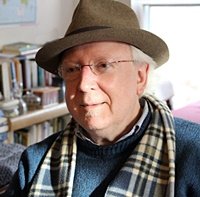REVISITING THE HOUSE OF THE SPIRITS: MYSTICISM, LOVE, AND MAGICAL SURREALISM
by Wally Swist
Although there are several competitive themes vying for the one central theme in The House of the Spirits, atonement, both divine and secular, runs deeply through Isabel Allende’s debut novel. Coming to atone for various shortcomings in vision and compassion as well as outright crimes perpetrated by one of the novel’s main characters, Esteban Trueba, perpetuate through a multi-generational absolution. What is crucial for resolve here is the attending consciousness of making atonement, which is intrinsic to its achievement, either full or partial—which also includes the significant act of forgiveness itself.
There is a strong current of feminism throughout the novel. Specifically, it can be referred to as a feminist view of history or even a proactive feminist historical perspective. The main female characters in the novel—Clara, Blanca, and Alba —who represent three generations of the del Valle-Trueba clan, are the purveyors of the true, and vast, family history. Political strongmen are seen as deleting truth or creating fake news for the sake of their regime, but it is women who are able to tell the tale truthfully. Ultimately, this also provides the opportunities for both atonement, then forgiveness, which is fluidly woven into the central theme.
The level of mysticism infused in The House of the Spirits is thoroughly enchanting. Clara often practices psychokinesis. She is also a clairvoyant, and predicts her sister’s death. The death of her sister—mermaid-like, with green hair—Rosa the Beautiful, although an early tragedy, also reveals the vulnerability in those psychically empowered. Through this Allende imparts that some of us may be able to move tables and predict the future, but we are all not immune from various tragic life experiences, such as the death of a loved one.
There is a dynamic of politics that is at the core of The House of the Spirits. When Esteban Trueba, then a hard leaning conservative, supports a junta against the government, he lacks the clarity of vision to see that it can, as it does, go far astray, and that the military dictatorship which he has helped install in his country proves to be unsafe for everyone. Ostensibly, Allende portrays the Pinochet coup d’état in Chile, in 1972, which she uses as an historical reference and which the novel shadows. In doing so, there is a struggle between socialism and fascism, and it is in the end which socialism triumphs.
******
It is the element of love which is the existential glue that holds The House of the Spirits together, ultimately. It is the spark of love between Esteban Trueba and Clara Del Valle, at the beginning that sets them ablaze with love. It is the love Esteban has his granddaughter, Alba (meaning “dawn,” in Spanish), which is persevering in that it leads to the possibility of Esteban’s eventual atonement, and what provides the dynamism for Alba’s magnanimous forgiveness of what has happened in the past for the del Valle-Trueba family. Essentially, also, it is Alba’s love for her grandfather that provides her the strength and the hope to break the karmic chain of revenge and hatred exhibited through the improvident practice of patriarchy.
As Allende’s character, Alba, says in The House of the Spirits, “the space of a single life is brief, passing so quickly that we never get a chance to see the relationship between events; we cannot gauge the consequences of our acts, and we believe in the fiction of the past, present, and the future, but it may also be true that everything happens simultaneously.” There are some physicists who believe that this is in fact possible and correct—that everything is, indeed, occurring at once. In light of this, Allende has not only written a brilliant family saga worthy of lengthy feminist critique, which also addresses the hostility of fascism, but has created a metaphysical fiction for the ages. She even prefaces the novel with a quote from Nobel Laureate, Chilean poet Pablo Neruda: “How much does a man live, after all?/ Does he live a thousand days, or one only?/ For a week, or for several centuries?/ How long does a man spend dying?/ What does it mean to say ‘for ever’?”
The Neruda quote only presages a novel that begins and ends with the same phrase: “Barabbas came to us by sea . . .” The child Clara writes that in her journal at the book’s beginning and Alba reads her grandmother’s words in that same journal decades later, “written in a child’s delicate calligraphy,” as the novel’s last words. In this, Allende creates a mythos in the book, alpha beginning it and alpha ending it, a dialectic resolved, an entire mythology, a feminist generational history, complete unto itself. It is stratagem and diadem, alike. It is multi-generational but dissolving into the timelessness it arose from and arising from the timelessness of our lives: alchemy and magic, at once.
What is significant is the portrayal of the severe male character of Esteban Truebo, the often cruel patron of Las Tres Marias, the family hacienda; the sometimes overbearing husband of Clara, and the harsh father of Blanca, whom he alienates when he cuts off three fingers of one of the hands of socialist revolutionary Pedro Tercero Garcia (whom is said to be modeled after folksinger Victor Jara) because Blanca and he were lovers.
Although feminist criticism rightfully condemns Esteban for his many wrongs, such as raping peasant women, such as Pancha Garcia, who births his bastard son, Esteban Garcia, Esteban’s character exhibits a transcendence from his incontrovertible and unyielding maleness, even a machismo, to transcend his previous actions, at least partially, through his acknowledgement of his crimes and misdemeanors, thereby atoning for them, especially in his helping Blanca and Pedro Tercero escape the junta to flee to Canada; then later in his petitioning his old friend, the prostitute, Transito Soto, who had influence with the military, in releasing his granddaughter Alba from her being held in a concentration camp.
Although his wife, Clara, kept her promise to never speak to him again after he knocked several of her teeth out in an argument relating to Blanca and Pedro having become lovers, on his deathbed, with his granddaughter Alba by his side, Esteban’s conscience is ameliorated in knowing that Clara has forgiven him, from beyond the grave, as he dies peacefully. It is then that Blanca begins to read her grandmother’s notebooks, “Barabbas came to us by the sea . . .“
******
Written in a style known as Magical Surrealism, Isabel Allende creates a family saga not dissimilar to Gabriel Garcia Marquez’s One Hundred Years of Solitude, published some twelve years earlier. Magical Surrealism employs paranormal events, mysticism, mythology, alchemy, and magic in establishing a mystic realm which appears to be more real than life itself. Through this literary necromancy, Allende, as does Marquez, creates a timeless world where past affects present, which then portends the future.
The House of the Spirits, although the work of Magical Surrealism, is also considered partially autobiographical and certainly historical, especially the parts of the novel regarding the coup d’état, since the author is the niece of Salvador Allende, president of Chile from 1970-1973, was overthrown by CIA-backed fascist strongman Augusto Pinochet, whose military arrested, tortured, and assassinated many Chileans, including many artists and writers, such as folksinger and guitarist, Victor Jara, whose hands and fingers were broken by Pinochet’s soldiers, but who continued to sing an anthem of freedom to his fellow countrymen in the soccer stadium they were imprisoned in, until he was shot multiple times. His body was said to have been shot by some forty bullets.
Sometime before her composing The House of the Spirits, Allende translated several romance novels into Spanish, most notably the work of renowned romance writer Barbara Cartland. Allende attributes her inspiration to writing The House of the Spirits to a long telephone conversation she had with her then 99-year-old grandfather, who was near death at the time. She began writing the novel after her composing a letter to her grandfather, which became the basis for the novel itself. Since she started writing the book on January 8th, every novel she has begun after that she also beings on the same date.
Initially, The House of the Spirits was rejected by several notable South American publishing houses before being published in Buenos Aires, in 1982. Upon publication, the novel nearly instantaneously made Isabel Allende an international literary success. She was awarded not only with the Best Novel of the Year in Chile but since then the book has been translated in more than 37 different languages worldwide.
About the Author:

Wally Swist’s books include Huang Po and the Dimensions of Love (Southern Illinois University Press, 2012), selected by Yusef Komunyakaa as co-winner in the 2011 Crab Orchard Series Open Poetry Contest, and A Bird Who Seems to Know Me: Poems Regarding Birds & Nature (Ex Ophidia Press, 2019), the winner of the 2018 Ex Ophidia Press Poetry Prize. His recent poems have or will appear in Commonweal, Rattle, and Transference: A Literary Journal Featuring the Art & Process of Translation. Recent books include The Bees of the Invisible (2019) and Evanescence: Selected Poems (2020), both with Shanti Arts.






















